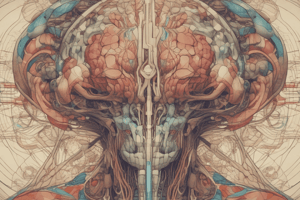Podcast
Questions and Answers
What is the primary function of the utricle and saccule?
What is the primary function of the utricle and saccule?
- To detect kinetic movement
- To regulate body temperature
- To detect sound waves
- To detect linear acceleration, deceleration, and static tilt of the head (correct)
What is the name of the fluid that fills the semicircular canals?
What is the name of the fluid that fills the semicircular canals?
- Perilymph
- Synovial fluid
- Cerebrospinal fluid
- Endolymph (correct)
What is the bilateral receptor system located in the membranous labyrinth?
What is the bilateral receptor system located in the membranous labyrinth?
- Auditory system
- Vestibular apparatus (correct)
- Visual system
- Olfactory system
What is the reason people feel dizzy after spinning around and suddenly stopping?
What is the reason people feel dizzy after spinning around and suddenly stopping?
What is the central vestibular system located in?
What is the central vestibular system located in?
What is the name of the nerve that transmits information from the peripheral vestibular system to the central nervous system?
What is the name of the nerve that transmits information from the peripheral vestibular system to the central nervous system?
What is the function of the hair cells located in the macula of the otolith organs?
What is the function of the hair cells located in the macula of the otolith organs?
What is the name of the structures that make up the kinetic labyrinth?
What is the name of the structures that make up the kinetic labyrinth?
What causes the stereocilia to bend in the direction of linear acceleration?
What causes the stereocilia to bend in the direction of linear acceleration?
What is the role of the otolith vestibular hair cells?
What is the role of the otolith vestibular hair cells?
What is the characteristic of vestibular hair cells at the resting stage?
What is the characteristic of vestibular hair cells at the resting stage?
Where do the sensory vestibular fibers arrive?
Where do the sensory vestibular fibers arrive?
What happens to the action potential frequency when the stereocilia are bent towards one side?
What happens to the action potential frequency when the stereocilia are bent towards one side?
Where are the vestibular hair cell canals located?
Where are the vestibular hair cell canals located?
What is the pathway of the vestibular nuclei to the spinal cord?
What is the pathway of the vestibular nuclei to the spinal cord?
What is the function of the cupula?
What is the function of the cupula?
What is the function of the fastigial nucleus and flocculonodular lobe?
What is the function of the fastigial nucleus and flocculonodular lobe?
What is the function of the thalamus in the vestibular pathway?
What is the function of the thalamus in the vestibular pathway?
What happens to the cupula during angular acceleration of the head?
What happens to the cupula during angular acceleration of the head?
What is the function of the maculae in the otolith organ?
What is the function of the maculae in the otolith organ?
Why can someone feel the car stopping when they are blindfolded?
Why can someone feel the car stopping when they are blindfolded?
Why can someone feel themselves going up or down when they are inside an elevator?
Why can someone feel themselves going up or down when they are inside an elevator?
Flashcards are hidden until you start studying
Study Notes
Vestibular System
- Divided into peripheral and central systems
- Peripheral system located outside of the brain, composed of vestibular apparatus in membranous labyrinth and vestibular portion of vestibulocochlear nerve (Cranial nerve 8)
Peripheral Vestibular System
- Vestibular apparatus consists of 3 semicircular canals (kinetic labyrinth) and 2 otolith organs (static labyrinth)
- Semicircular canals are filled with endolymph and surrounded by perilymph
- Otolith organs consist of utricle and saccule, which detect linear acceleration, deceleration, and static tilt of the head
Central Vestibular System
- Located in cerebellum and brainstem, contains 4 pairs of vestibular nuclei on each side
- Functions include maintaining balance and coordination of eye-head-body movements
Vestibular Hair Cells
- Located in macula of otolith organs
- Tonic ally active cells at resting stage with constant firing rate
- Bending of stereocilia towards one side increases action potential frequency, while bending in opposite direction decreases frequency
- Change in frequency of action potentials indicates which side the body is moving
- Hair cells in semicircular canals are covered by cupula, a gelatinous mass
- During angular acceleration, cupula is displaced, causing excitation or inhibition of hair cells
- All 6 canals activation provides precise indication of head movement in 3 dimensions
Otoliths
- Located in macula of otolith organ, with otolith mass overlaying vestibular hair cells
- Maculae have hair cells oriented in different directions to detect linear movement in different angles
- Macula of utricle is horizontally oriented, while macula of saccule is vertically oriented
- Maculae specialized for sensing linear acceleration, such as gravity acting on tilting head or head moving in straight line
- Gravitational or inertial forces cause stereocilia to bend in direction of linear acceleration
Vestibular Pathway
- Sensory vestibular fibers arrive at 4 vestibular nuclei and cerebellum
- Cerebellum projects to vestibular nuclei, spinal cord, brain stem, and thalamus
- Vestibular nuclei project to spinal cord, brain stem, cerebellum, and thalamus
Studying That Suits You
Use AI to generate personalized quizzes and flashcards to suit your learning preferences.




